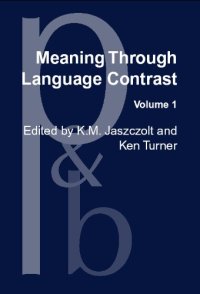
Ebook: Meaning Through Language Contrast, Volume 1
- Series: Pragmatics & Beyond New Series 99
- Year: 2002
- Publisher: John Benjamins
- Language: English
- pdf
The discussion of the boundary between semantics and pragmatics has also undergone various changes of emphasis and style. In the 1970s, sense-generality and pragmatic inference were brought to the fore (see e.g., Cole 1981; Atlas 1989; Turner 1999; Jaszczolt 1999). Almost two decades later, dynamic perspective in semantics allowed for contextual information to be semanticized (see Kamp & Reyle 1993). Subsequent developments of the idea of underspecification (see e.g., van Deemter & Peters 1996) demonstrated that pragmatics, intentions and intentionality are frequently irreducible and do not yield to formalizations (see Blutner & van der Sandt 1998; van Deemter 1998; Dekker, forthcoming; Jaszczolt & Turner, forthcoming). The predominance of semantic analyses strongly suggests that (i) contrasting meaning in various natural languages requires firm foundations, strict modelling and some degree of formalization; (ii) both (a) cognitive semantics and (b) Tarskian, post-Montagovian semantics supplemented with post-Gricean pragmatics are more productive than the offshoots of the ordinary language philosophy. Finally, to address the empiricism-rationalism dilemma, it can be observed that inferring from quantitative analyses and supporting theories by unquantified data constitute equally successful directions in semantic and pragmatic research.
Download the book Meaning Through Language Contrast, Volume 1 for free or read online
Continue reading on any device:

Last viewed books
Related books
{related-news}
Comments (0)